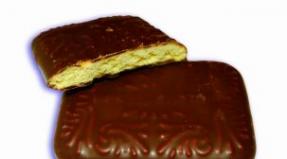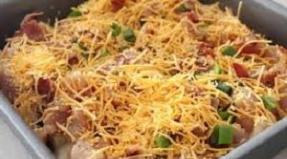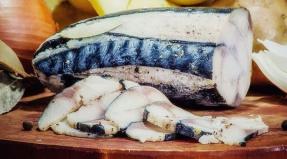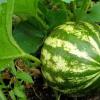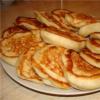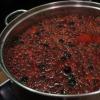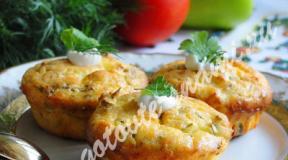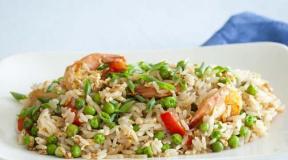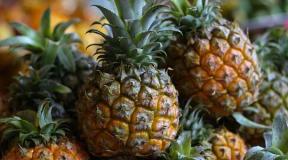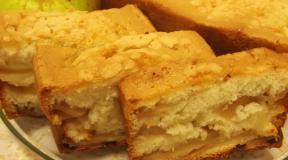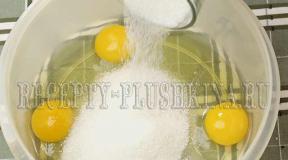What can be cooked from whole grains. Whole Grain Recipes
Over one year old
One of the basic tenets of a healthy diet is that carbohydrates should account for 55-60% of all calories consumed. Because carbohydrates are our everything! It is the main fuel for the body, activating not only the muscles, but also the brain. With a lack of them, we will experience lethargy and apathy, any, even the most elementary work is given to the limit of strength. Nutritionists believe that it is these macronutrients that most women around the world owe their slimness. True, they add: we are talking mainly about complex carbohydrates - the very ones that are rich in whole grains: bread, flour, pasta, brown rice and other unpolished cereals. The main thing is that the grain is whole, that is, not peeled from its natural shell.
Facts are stubborn things
Eat more whole grains and your weight will drop - this is the verdict of modern science. A massive 12-year Harvard study of 74,000 women of all ages found that the leanest were those with a diet rich in whole grains. Scientists from another American state, Louisiana, came to a similar conclusion after observing 149 women. What is the secret of unprocessed grain? In its shell, which is almost 100% composed of insoluble coarse fiber. But it is she who is the most powerful weapon in the fight against extra pounds. So, in 1/2 cup of brown rice there are almost 2 g of this substance, while in white rice its content is negligible. Insoluble fiber not only improves digestion and, like a brush, cleanses the intestines from toxins, it also helps to avoid overeating. The mechanism of this action is not yet fully understood, but nevertheless it has been proven that coarse dietary fibers cause and intensify the impulses sent by the stomach to the brain that it is time to put the fork aside.
Whole grain menu
Now you know what food is best for helping you lose weight. All that remains is to figure out how to make it work for you smoothly. Nutritionists recommend consuming 6 servings of cereals per day including them at every meal. For example,
- for breakfast, eat a plate of oatmeal (120 g - 1 serving), but not instant oatmeal,
- for lunch - 2 slices of whole grain bread (2 servings),
- for an afternoon snack - 2 grain loaves (1 portion), it is possible with melted cheese,
- and for dinner - wholemeal spaghetti (1 glass is equivalent to 2 servings).
However, for all their power, whole grains are powerless without other rules of a healthy diet and exercise. So remember to eat 2 1/2 cups of vegetables, 2 cups of fruits, and 150 g of lean protein meals daily. And our recipes will help you with this.
Grain under the microscope What is whole grain? It consists of an embryo, nutrient-rich endosperm and a dense shell that protects the future plant from an aggressive environment. If this trinity is not violated by the rough invasion of the food industry, then you will receive a loading dose of fiber, magnesium, vitamins E and group B, as well as phytoelements important for beauty and health - flavonoids, lignans and saponins.
PIZZA WITH WHOLE GRAIN CLUSTER AND CHICKEN SAUSAGE
Serves 8 // Cook: 20-25 minutes

- Coarse flour pizza base (300-400 g)
- 1 tbsp. l. olive oil
- 1 semi-smoked chicken or turkey sausage (150-180 g), cut into 1 cm thick slices
- 1 medium red onion, chopped into rings
- 1/3 cup whole grain couscous
- 1/2 glass of water
- 2 tbsp. l. chopped oregano
- 1 tsp salt
- 1/4 tsp ground black pepper
- 1/3 cup tomato sauce
- 1/2 cup fresh basil, minced
- 120 g grated mozzarella cheese (about 1 cup)
- 60 g grated Parmesan cheese (about 1/2 cup)
- Preheat oven to 200 ° C. Grease a baking sheet and place the pizza base on top.
- Fry the onion and sausage in a saucepan in olive oil. When the onion is soft, add the couscous, oregano, salt, pepper, cover with water and cover. Bring to a boil, turn off heat and let stand for 5 minutes. Remove the lid, stir the contents of the saucepan with a fork and cool to room temperature.
- Cover the pizza base evenly with tomato sauce, top with the couscous and sausage mixture, sprinkle with basil and cheese.
- Bake for 15-20 minutes, until the dough and cheese are lightly browned. Allow the pizza to cool for 5 minutes before slicing.
Nutritional information for 1 serving (1/8 of a pizza): 215 kcal, 9 g fat, 29 g carbohydrates, 14 g protein, 2 g fiber, 223 mg calcium, 3.6 mg iron, 941 mg sodium.
SPICY HAMBURGERS WITH WHEAT SALAD, CUCUMBER AND CHEESE
Serves 4 // Cook: 20-25 minutes

- 2 1/2 cups unsalted chicken stock or water
- 1 glass of millet
- 1 tbsp. l. salt
- 500 g ground beef
- 3 green onion feathers, chopped
- 2 tsp ground cumin
- 1/2 tsp cayenne pepper
- 1-2 minced garlic cloves
- 4 slices of tomato
- 4 lettuce leaves
- 1 medium cucumber, peeled and diced
- 3 tbsp. l. chopped oregano
- 2 tbsp. l. fried pine nuts
- 60 g crumbled cheese
- 2 tsp lemon juice 1 tbsp. l. olive oil
- Salt and pepper to taste
- 4 whole grain buns
- Bring chicken stock to a boil. Pour in the millet, salt, cover and simmer until tender: the cereal should boil down and absorb all the liquid. Remove the porridge from the stove, stir with a fork and leave covered for 5 minutes.
- Transfer half of the cooled porridge to a separate bowl, add minced meat, half green onions, cumin, cayenne pepper and garlic. Mix everything well (preferably with your hands) and mold 4 flat cutlets.
- Fry them in a skillet or grill until cooked through.
- Cut each whole grain bun in half: on the bottom half, place first a leaf of lettuce, then a cutlet and a round of tomato, and cover with the other half.
- Make a salad by mixing leftover millet porridge with onions, cucumber, oregano, pine nuts, and feta cheese. Season with lemon juice and olive oil, salt and pepper.
- Serve burgers with salad.
Nutritional information for 1 serving (1 hamburger + 1/2 cup salad): 579 kcal, 16 g fat, 81 g carbohydrates, 35 g protein, 18 g fiber, 190 mg calcium, 5.4 mg iron, 672 mg sodium.
PUDDING WITH BROWN RICE, OAT AND RAISINS
Serves 4 // Cook: 35-45 minutes

- Vegetable oil
- 3/4 cup instant brown rice
- 2 tbsp. l. oatmeal
- 1/2 tsp ground cinnamon
- 2 eggs
- 3 tsp Sahara
- 1/2 tsp vanilla powder
- 1 cup 1% milk
- 1/4 cup raisins
- Preheat oven to 170 ° C. Grease heat-resistant glass glasses and place in a deep pan.
- Divide the rice into glasses, then the oatmeal and sprinkle with cinnamon.
- Combine eggs, sugar, vanillin, milk and whisk in a separate bowl. Pour the resulting mixture over the contents of the glasses, and put the raisins on top.
- Pour hot water into a baking dish up to 2/3 of the height of the glasses and put everything in the oven for 35-45 minutes.
- Check the doneness with a match - it should come out dry from the center of the pudding.
- Remove the glasses with dessert from the water and cool to room temperature.
Nutritional information for 1 serving (1 cup of pudding): 184 kcal, 4 g fat, 30 g carbohydrates, 7 g protein, 2 g fiber, 111 mg calcium, 1 mg iron, 67 mg sodium.
In contact with
Since time immemorial, people have been growing crops. Much has been known about the benefits and value of cereals for a very long time. The most common crops are, of course, wheat, rice, buckwheat, oats and millet (millet). Here are some options for what you can make with these grains.
In addition to flour, wheat grains are used to make semolina, familiar to everyone from childhood, by coarse grinding. For example, in the Baltic States and Germany, pubertas are made from it - this is when semolina is brewed with fruit juice and milk with an egg. The use of wheat is truly unlimited, not only in the manufacture of cereals, but also various cereals, kvass, tinctures and decoctions are made.
Buckwheat grain has long been famous in Russia. Various cereals and jelly are made from it. Due to its low gluten content, buckwheat flour was not suitable for baking bread, but it was well suited for pancakes, tortillas and dumplings. In Japan, buckwheat is used to make soba noodles, which are very popular in the East. And in China, buckwheat is used to make jam, chocolate and even liqueurs.
One of the most useful and even healing crops is oats. Widespread throughout the world, this cereal owes its medicinal properties, such as lowering cholesterol levels, strengthening bones and teeth, and facilitating the absorption of fats. In Ireland, oats are fried and made into vegetarian sausages. In France, oat grains are added to exquisite soups. In the USA, oats are used in the preparation of the famous "Boston" black bread. Oatmeal jelly and oatmeal cookies, loved by children, are widely known in Russia.
The inhabitants of the Russian North have been growing millet (millet) for a very long time, because they knew that this grain gives a person strength. And so they made porridge, flour, beer from it, added it to soups and various sweet dishes. Every ear that is loved by fishermen and tourists, also does not do without millet grains. Currently, the most popular millet dish is "friendship" porridge when millet is mixed with rice.
You can write a whole book about rice known to the whole world. Its many varieties are divided into three main types. In the East and Asia, all main dishes are made from rice. In Japan, these are sushi, rolls, side dishes for seafood. In China, the famous rice noodles are made from it. In Asia and the Caucasus, rice has found its main application in various types of pilaf and other national dishes.
Switching to whole grains!
Want to lose weight and improve your health, reduce your risk of heart disease, stroke, diabetes? Provide your body with the necessary amount of fiber! Whole grains, which should always be present in the diet, provide the greatest benefits of fiber-rich foods.
Whole grain foods contain whole grains such as brown rice, wheat, oats, and other crops. Each of them consists of three distinct parts: a protective bran shell, which is saturated with fiber, a starchy core called endosperm, and a nutrient-rich grain embryo.
The uncompromising statistic is that people who eat a lot of whole grains tend to have a lower BMI and a smaller waist, and avoid heavy weight gain in old age. A packaging label can help you find foods with whole grains in stores.
- For information on fiber, see the nutritional information section. Whole grain foods contain at least 2 grams of fiber per serving. But having fiber alone doesn't mean you have whole grains in front of you, so take a close look at the list of all the ingredients.
- Buy foods with ingredients that start with the word “whole” as a signal to you. For example, whole grain flour and whole oats are whole grains, while fortified wheat is not, as is everything refined.
- Check the ingredient list carefully when you see descriptions of grain like “crushed wheat”, “multigrain”, “milled”, etc. on the package. Such labels do not necessarily mean that the product is whole grain.
Switching to whole grains
So, the whole grains are bought, but the problem is that few people can bring themselves to immediately switch to this rough food. Therefore, a smooth transition is recommended.
- Choose foods that contain whole grains rather than refined grains.
- Be sure to include one whole grain product in all your main meals: for example, you can eat a slice of whole grain bread for breakfast, whole grain porridge or a side dish with whole grain pasta for lunch, and boiled rice for dinner.
- If some whole grains are completely unpalatable to you, don't despair and give them up right away. Just carefully study food labels with the word "whole grain" and taste more and more new "discoveries". Look for products made from whole grain white flour in stores - it makes real culinary masterpieces: delicious, tender and healthy.
- Include some whole grains in a wide variety of dishes; they work well in salads, soups, and side dishes.
- You can always have a "travel kit" of whole grains with you to snack on.
Finally, get creative: create your own wholegrain dishes. Cook them on the stove, in the oven, in a double boiler and in the airfryer - this will help you diversify the taste of healthy dishes and at the same time feel how the hated kilograms go away.

What to cook with whole grains?
The effectiveness of the diet is largely determined by how appetizing the dishes are prepared within its framework. Therefore, the best way to pamper yourself while losing weight is to learn how to cook delicious foods rich in fiber.
Whole grains are the main source of fiber, which can help you lose weight quickly and effectively. Therefore, feel free to include them in your diet, and after a week the arrow of your weights will gradually begin to approach the coveted figure.
In order to properly use grain products for the preparation of a particular dish, you need to know their basic properties. The table will help you to understand the variety of whole grains and choose what dishes you can make from them.
| Grains | Description of how to buy | What dishes does it suit |
| Barley | It can be bought both whole and crushed. | Soups, salads, breakfast cereals. |
| Brown rice (wild, colorful) | You can buy short, medium, long grain. | Side dishes. |
| Buckwheat | Revered in Russia since ancient times. | Side dishes, cereals. |
| Bulgur | Wheat grains: crushed, boiled and dried. Groats have become very popular among Russians in a short time. | Side dishes, salads, minced meat. |
| Millet | Small grains with a very pleasant, unique taste, which is perfectly felt in cereals and side dishes. | Porridge, side dishes. |
| Corn | Corn kernels can be bought in a wide variety of varieties (fried, ground, fresh, frozen). | Side dishes, cereals, pastries. |
| Quinoa | Grain culture, which has not yet been discovered by everyone. It has a pleasant nutty flavor. | Side dishes, salads. |
| Oats | A popular cereal that can be purchased either unprocessed or flaked. | Porridge, pastries. |
| Rye | From this cereal you need to bake as often as possible: the same pancakes, cookies and pies. | Bakery. |
| Wheat | This cereal crop needs no introduction. | Pasta, side dishes, cereals. |
By learning how to competently cook whole grains, you can enjoy a delicious and varied diet. Include dishes with whole grains in your menu at least three times a day - and your figure and health will delight you!
The right breakfast is a guarantee that all goals will be achieved today. It consists of a mix of slow and fast carbohydrates, complete proteins, and the right fats. Such a mix is given to us with whole grains, nuts, eggs or cheese, a slice of rye bread with butter, fruit or dark chocolate for dessert.
Very often there is no time left for a full breakfast. I would like to have a quick and easy snack and hurry to the road. Therefore, we drink a glass of coffee on the go, eat a cookie and run to work. And after 1-2 hours you want to pounce on chocolates and buns. Sound familiar?
But getting the right breakfast is just a matter of habit, and if you think about it, it doesn't take too long to prepare.
In order for everything to work out, you must:
- Stock up on the right helpers- that is, healthy products that do not require long cooking.
- Allocate time and make an approximate list of dishes you are familiar with, on which no more than 15 minutes is spent.
- Plan ahead in the evening than you will have breakfast in the morning.
Well, we will help you with this :)
Not all cereals are created equal.
The first thing that comes to mind when it comes to breakfast is morning porridge. But not all cereals are created equal.
And this is the problem faced by those who want to eat right, but there is not enough time at all:
- Instant porridge are made from processed grains, in which, except for starch, nothing is left. We only get fast carbohydrates, as a result, very soon we will want to eat again.
- Whole grain porridge with a shell, a starchy part and a germ - much more nutritious, healthy and rich in vitamins. These are slow carbohydrates that will saturate for a long time! There is one "but" - they require a long cooking, which does not always have time. What to do?
Chopped grain cereals "Lifestyle" are able to solve these problems They retain all parts of the whole grain, in contrast to processed industrial cereals. Due to the fact that the grain is cut into uniform plates, it quickly absorbs water, does not require pre-soaking and cooks in half the time. All the nutrients, vitamins, useful elements, the fiber we need, and slow carbohydrates remain in cereals from chopped grains. Convenient and useful!
Cereals are already packaged in portioned packages: one package - one breakfast, so you don't need to calculate your portion for a long time. If you, for example, keep a food diary, this is very convenient.
Breakfast ideas
For the preparation of breakfasts, we took seven "Lifestyle" cereals as a basis. You can delight yourself with nutritious and healthy yummy for a whole week!
Green buckwheat is a source of vitamins of group B, C, E, as well as iron, phosphorus, magnesium, zinc and, importantly, complete vegetable protein. Thanks to the content of organic acids, buckwheat helps the body to better absorb iron, which it is rich in, which is why plant-based nutritionists love it so much.
We are all accustomed to the taste of buckwheat porridge since childhood. Maybe we can cook it in a new way?
Cook green buckwheat in boiling lightly salted water. Pour the prepared porridge into a cup, add a little coconut milk, chia seeds and syrup instead of sugar to taste. Cover and let it brew for 10 minutes. At this time, cut your favorite fruit. Then garnish the porridge with them and enjoy a delicious breakfast!
Green buckwheat in this breakfast is our slow carbohydrates, fruits are a mix of fast carbohydrates and fiber, and chia seeds are vegetable protein and healthy fats.

Porridge made from chopped naked oats retained all the beneficial properties - B vitamins, zinc, potassium, phosphorus and other elements.
Such porridge helps the gastrointestinal tract work, perfectly nourishes and nourishes, and it is also a good base for making a delicious breakfast.
Delicious oatmeal can be prepared without adding milk. But nevertheless, it is worth adding protein to it - it will be more satisfying. So don't forget to garnish your meal with a handful of your favorite nuts.
Boil one bag of oatmeal in salted water. Now it remains to mix it with different seasonings: add some nuts, cinnamon, nutmeg, ginger and cardamom to taste, stir and place the apple slices on top. Optionally, you can add coconut flakes - it will be even tastier!
If you like sweeter porridge, add a little ginger syrup. Healthy nuts are a source of protein in our breakfast.

We hope you already know about the spelled? This is the grandmother of modern wheat. It has the same properties, and in some ways even surpasses it.
Spelled contains a large amount of vegetable protein, B vitamins, folic acid, selenium, calcium and other important substances.
It usually takes time to cook spelled porridge, but chopped spelled grains will boil down in minutes.
Fill a bag of chopped spelled grains with a glass of hot water, add a little lemon juice and leave overnight. In the morning, we send the contents to a blender along with a spoonful of honey and cocoa. Puree everything well and pour into a plate. Decorate the porridge with apple slices.
For a creamier and richer porridge, you can add a little nut butter to provide your breakfast with an additional source of protein.

Wheat grains are another important source of slow carbohydrates, and with them energy and strength. If all the components remain in the wheat grain, then it perfectly saturates and nourishes with useful elements. Wheat porridge has a mild sweet taste - you can even do without sugar.
Yes, in order to cook pumpkin porridge quickly, the pumpkin will have to be cooked in advance, in the evening. Then puree the soft pieces and leave overnight. In the morning, mix pumpkin puree with milk - here coconut is very suitable for us - and bring to a boil. Then add a bag of chopped wheat grains and let the porridge simmer under the lid for a few minutes. Delicious pumpkin porridge is ready!
Add grated cheese or some nuts to the porridge to complement our breakfast with protein and healthy fats.

To prepare porridge, it is very important to use brown rice, which, unlike its white counterpart, has not been polished. Rice helps to better assimilate proteins from food, normalizes digestion and is suitable for preparing a variety of dishes, from soups to desserts. Let's try to cook a quick savory porridge with it.
For this dish, we need a couple of minutes more than usual. We put the eggs to boil. In the meantime, cut the onion into slices and put in the pan. After that, add your favorite spices to the onion - for example, turmeric, and fry for a couple of minutes. Put the contents of the bag of chopped rice grains into the pan and season with half a glass of unsweetened yogurt. After a couple of minutes, the porridge can be removed from the heat.
Garnish with chopped herbs and grated egg. If there is no time at all, you can simply cut the eggs into halves and put them next to the porridge.

Rye is a source of complete plant protein. It helps to strengthen the immune system and takes care of our health. This cereal contains a lot of vitamins and useful elements: B vitamins, folic acid, calcium, iron, magnesium and others. And you can cook from it not only delicious bread, but also no less tasty porridge.
Undoubtedly, the good advice of many nutritionists to consume grains the way our ancestors consumed them, rather than refined flour and polished rice, is misleading and often has negative consequences. Our ancestors consumed whole grains but they never cooked them the way they do in modern cookbooks: quick-match bread, granola (muesli) and other quick-cooking casseroles and dishes. Our ancestors and all uncivilized peoples soaked or fermented grains before preparing porridge, bread, pies, and cereal dishes. One glance at the recipes of the peoples of the world is enough to confirm this point of view.

In India rice and lentils fermented for at least 2 days before preparing idli and dosas. In Africa, locals soak coarsely ground corn overnight before adding it to soups and broths, and they also ferment corn and millet for several days to make a porridge called orgi. A similar dish, but made from oats, was traditional among the natives of Wales. In some Eastern and Latin American countries, it is customary to ferment rice for a long time before cooking.

Ethiopians make their outstanding bread injera, fermenting a grain called teff for several days. Mexican corn tortillas, called pozol, are fermented in banana leaves sometimes for two weeks. Before the invention of fast yeast, Europeans made their bread with fermented sourdough. America's early settlers were famous for their bread, pancakes, and sourdough pastries. And, finally, all over Europe, grains were pre-soaked overnight, and sometimes for several days, in water or sour milk, before making porridge or gruel from them. (Many older people probably remember that earlier on the packaging with oatmeal it was written about pre-soaking for the night).

There is no point in making assumptions about what intuitive feeling made our ancestors soak and ferment grains before consuming them. More importantly, this ancient technique fits well with what modern grain science has discovered recently. All grains contain phytic acid (an organic acid that binds phosphorus) in the outer shell of the grain. Unneutralized phytic acid can combine with calcium, magnesium, copper, iron, and especially zinc in the intestine, and thus hinder their absorption.
This is why a diet that includes the consumption of unfermented whole grains can lead to severe mineral deficiencies and bone loss. The fashionable and incorrect practice of consuming large amounts of unprocessed bran often improves digestion and relieves constipation at first, but can subsequently lead to irritable bowel syndrome and, over a longer period of time, other undesirable consequences.
Soaking allows enzymes, lactobacilli and other friendly microorganisms to break down and neutralize phytic acid. Just 7 hours of soaking in a warm, slightly acidic environment neutralizes most of the phytic acid in the beans. Simply soaking ground cereals and cereals overnight greatly improves their nutritional value.
Soaking in warm water also neutralizes enzyme inhibitors that are present in all seeds and promotes additional production of a number of enzymes. The action of these enzymes, in turn, increases the amount of vitamins, especially B vitamins.

Scientists have discovered that the proteins in grains, especially gluten, are very difficult to digest. A diet high in unfermented whole grains that are high in gluten, such as wheat, puts a heavy strain on the digestive tract. When the digestive process is disturbed due to age or heavy workload, painful conditions develop in the form of allergies, celiac disease, mental disorders, chronic gastrointestinal diseases and the growth of candida albicanis. Recent research has linked gluten intolerance to multiple sclerosis. During the steeping and fermentation process, gluten and other difficult-to-digest proteins are broken down into simpler constituents and are better absorbed.
Animals that feed mainly on grains and other plants have as many as 4 stomachs (4 sections of the stomach). Their intestines are longer, as well as the total digestion time. Man has only one stomach and, in comparison with herbivores, the intestines are much shorter. This feature of human anatomy allows products of animal origin to enter the intestines before decomposition begins in them, but makes a person less adapted to the consumption of grains - unless, of course, he does not allow bacteria from the microcosm in the plate to do part of the work of digestion for him. since it is these lactobacilli that work on digestion in the first and second stomach of herbivores.

Grains can be divided into two categories. Those containing gluten, such as oats, rye, barley and especially wheat, should never be consumed without first soaking or fermenting; buckwheat, rice and millet are gluten-free and are generally much better digested. Whole rice and whole millet contain the fewest phytates than other grains and therefore do not need to be soaked too much. However, they should be boiled for at least 2 hours in a highly nutritious gelatin broth. This will break down the phytates that they contain and replenish those minerals that still remain bound, and the gelatin in the broth will greatly aid digestion. We do not recommend pressure cookers for cooking cereals as they cook them too quickly.

There are several types of cereals that are new to the Western ear. One of them - spelled (spelled), an ancient variety of wheat that was prized by the medieval sage Saint Hildgard for helping the sick and people with weak constitutions a lot. Spelled contains gluten and is very suitable for sourdough bread. Some studies show that spelled gluten is easily degraded during fermentation, making it easier to digest than modern wheat varieties. In most bread and baking recipes, spelled can replace modern wheat.

Another ancient non-hybrid wheat variety - kamut, the first mention of which dates back to the early Egyptian era. Some people who are allergic to modern wheat varieties do better if they use spelled or kamut instead.

Teff Is a grain from North Africa that is necessarily fermented before being baked into bread.

Quinoa came to us from the South American Andes and was first described in Western literature by Dr. Weston Price. He noted that women in the Andes prized quinoa for its ability to influence breast milk production. Botanically, quinoa is not a grain, but the seed of a plant of the Hibiscus family, which has a high nutritional value. All types of quinoa should be soaked - the Andes recognized that this neutralized antinutrients.

Amaranth Is another South American grain that can be used in many of the recipes later in the book.

Buckwheat- another forgotten cereal - prized for its high content of amygdalin (laetrile, vitamin B17, nitrilosides), which prevent cancer. Like quinoa, buckwheat is botanically not a grain. It is the seed of a plant related to rhubarb.
All our breakfast recipes are porridge, which have been pre-soaked overnight. If you buy ground grains or flakes, then you should buy them only if they are in a package, and do not take them in bulk, as then they will quickly go rancid. It is much better to buy organic or biodynamic (biodynamic) whole grains and grind or flatten them into flakes at home using a special mill. You can also add a small amount of ground flaxseed to start the day with omega-3 fatty acids. (Flaxseed contains some phytic acid and does not need to be presoaked if consumed very little.) Such cereals go very well with cream or butter, the fat-soluble activators of which are a necessary catalyst for the absorption of minerals. Usually, people with milk allergies can tolerate a small amount of cream in porridge or can eat porridge with butter - a magic combination. We do not recommend soy milk, which is high in anti-nutrients.

We also don't recommend granola (muesli) Is a popular "healthy" dish made from dry-heated grains and therefore very difficult to digest. Granola, like all industrially modified breakfast cereals, shouldn't take up shelf space in your kitchen. Breakfast cereals are made using an extrusion process where small flakes and various shapes are formed using strong heat and pressure. The extrusion process destroys many valuable substances in the grain, makes unstable oils rancid, and makes some proteins toxic. To raise a healthy generation of children, we should go back to the breakfast of our ancestors - pre-soaked porridge and gruel.

A few words about corn: traditional recipes talk about soaking corn and cornmeal in lime water to release nicotinamide (vitamin B3, PP), which otherwise remains bound in the grain. Soaking also improves the amino acid composition in the germ. If you frequently use corn in your cooking, the simple practice of soaking corn in lime water will avoid pellagra, a disease caused by vitamin B3 (PP) deficiency, which manifests itself as sore skin, fatigue, and mental distress. To make lime water, place 1 ounce (28 grams) of sauerkraut lime in a 2 liter jar. Fill the jar with filtered water, stir well, seal tightly and leave overnight. During the night, a precipitate will fall out, and the remaining clear liquid is lime water. Keep the jar in a cool place (not necessarily in the refrigerator) and use to soak the corn by pouring some water out of the jar. You can also use industrially prepared masa flour, which is made from corn soaked in lime water before grinding. However, like all whole grains, corn contains oils and goes rancid quickly, which gives it a bitter taste, so it's best to grind it into flour yourself.
the site warns, self-medication is dangerous to your health! Be sure to consult your doctor!
Partner news
Partner recipes
Read also ...
- Recipes for making coffee with ice cream at home
- Strawberry panna cotta - a classic of world culinary What is panna cotta with strawberries
- Cream of curd cheese for cake - the best recipes for impregnating and decorating dessert
- Profiterole recipe and three original custard recipes Protein cream for profiteroles
